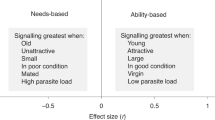Macho courtship by the satin bowerbird is tempered to avoid frightening the female.
Abstract
Models of sexual selection generally assume that behavioural courtship displays reflect intrinsic male qualities such as condition, and that males display with maximum intensity to attract females to mate1. Here we use robotic females in a field experiment to demonstrate that male satin bowerbirds (Ptilonorhynchus violaceus) do not always display at maximum intensity — rather, successful males modulate their displays in response to signals from females. Our results indicate that sexual selection may favour those males that can produce intense displays but which know how to modify these according to the female response.
This is a preview of subscription content, access via your institution
Access options
Subscribe to this journal
Receive 51 print issues and online access
$199.00 per year
only $3.90 per issue
Buy this article
- Purchase on Springer Link
- Instant access to full article PDF
Prices may be subject to local taxes which are calculated during checkout


Similar content being viewed by others
References
Andersson, M. Sexual Selection (Princeton Univ. Press, Princeton, New Jersey, 1994).
Borgia, G. & Presgraves, D. C. Anim. Behav. 56, 1121–1128 (1998).
Borgia, G. Am. Sci. 83, 542–548 (1995).
Berglund, A., Bisazza, A. & Pilastro, A. Biol. J. Linn. Soc. 58, 385–389 (1996).
Borgia, G. in Sexual Selection and Reproductive Competition in Insects (eds Blum, M. S. & Blum, N. A.) 27–49 (Academic, New York, 1979).
Mateos, C. & Carranza, M. Behav. Ecol. Sociobiol. 45, 235–244 (1999).
Borgia, G. Emu 95, 1–12 (1995).
Uy, J. A. C., Patricelli, G. L. & Borgia, G. Proc. R. Soc. Lond. B 267, 251–256 (2000).
Borgia, G. Anim. Behav. 33, 266–271 (1985).
Author information
Authors and Affiliations
Corresponding author
Rights and permissions
About this article
Cite this article
Patricelli, G., Uy, J., Walsh, G. et al. Male displays adjusted to female's response. Nature 415, 279–280 (2002). https://doi.org/10.1038/415279a
Issue Date:
DOI: https://doi.org/10.1038/415279a
This article is cited by
-
Male–male associations in spotted bowerbirds (Ptilonorhynchus maculatus) exhibit attributes of courtship coalitions
Behavioral Ecology and Sociobiology (2022)
-
Sand-bubbler crabs distinguish fiddler crab signals to predict intruders
Behavioral Ecology and Sociobiology (2021)
-
Artificial shaking signals in honey bee colonies elicit natural responses
Scientific Reports (2020)
-
Do female zebra finches prefer males exhibiting greater plasticity in foraging tactic use?
Behavioral Ecology and Sociobiology (2020)
-
Multiple signals predict male mating success in the lek-mating lesser prairie-chicken (Tympanuchus pallidicinctus)
Behavioral Ecology and Sociobiology (2020)
Comments
By submitting a comment you agree to abide by our Terms and Community Guidelines. If you find something abusive or that does not comply with our terms or guidelines please flag it as inappropriate.



